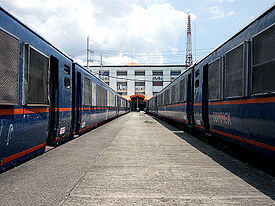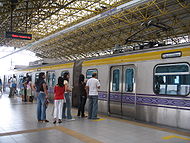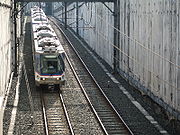
Rail transport in the Philippines
Encyclopedia
Rail transport in the Philippines is a growing means of transportation for passengers and cargo in the country. Such means of transportation are used typically for rapid transport within major cites as well as long distance travel. The Philippine railway network consists of one commuter rail service provided by the Philippine National Railways
(PNR), and a rapid transit system operated by the Light Rail Transit Authority
and Metro Rail Transit Corporation
. All three services are integrated through the Strong Republic Transit System
, a project of President Gloria Macapagal-Arroyo
in 2003 which aims to provide a "reliable, seamless and integrated mass transit system that would be at par with international standards" through the unification of already-existing rail infrastructure under one transit system and fare structure.
 The Philippine National Railways is a state-owned railway system
The Philippine National Railways is a state-owned railway system
in the Philippines
, organized under the Department of Transportation and Communications
(DOTC) as an attached agency. Established during the Spanish colonial period, the modern PNR was developed only in 1984. It formerly operated around 479 kilometres of track on the island of Luzon
, where most Philippine rail infrastructure is located. Because of this, PNR has become synonymous with the Philippine rail system.
A portion of the PNR network, specifically the Metro Manila
portion of the network, is part of the Strong Republic Transit System
(SRTS), and overall public transport
system in the metropolis. It forms the backbone of all of Metro Manila's regional rail
services, which extend to its suburbs and to provinces such as Laguna. However, other than reducing growing traffic congestion
due to the rising number of motor vehicles in Metro Manila, PNR also aims to link key cities within in the Philippines efficiently and to serve as an instrument in national socio-economic development. However, the meeting of that goal has been beset with problems regarding degraded infrastructure and a lack of government funding, problems that are being rectified with current rehabilitation efforts. The rehabilitation of PNR, which has been touted by various administrations, seeks to not only tackle those problems, but also to spur Philippine economic growth through an efficient railway system.
 The Manila Light Rail Transit System is the main metropolitan rail system serving the Metro Manila
The Manila Light Rail Transit System is the main metropolitan rail system serving the Metro Manila
area in the Philippines
. There are two lines to the LRT: LRT-1, called the Yellow Line
, and MRT-2, called the Purple Line
. Although the system is referred to as a "light rail
" system, arguably because the network is mostly elevated, the system is more akin to a rapid transit
(metro) system in European-North American terms. The Manila LRT is the first metro system in Southeast Asia
, built earlier than the Singapore MRT
by three years. The system is not related to the Manila Metro Rail Transit System
, or the Blue Line, which forms a completely different but linked system.
 The Manila Metro Rail Transit System has a single line, MRT-3 or the Blue Line. Although it has characteristics of light rail
The Manila Metro Rail Transit System has a single line, MRT-3 or the Blue Line. Although it has characteristics of light rail
, such as the type of rolling stock
used, it is more akin to a rapid transit
system. It is not related to the Manila Light Rail Transit System
, a separate but linked system.
One of its original purposes was to decongest Epifanio de los Santos Avenue
(EDSA), one of Metro Manila's main thoroughfares and home to the MRT, and many commuters who ride the MRT also take road-based public transport, such as buses, to reach the intended destination from an MRT station. MRT has been only partially successful in decongesting EDSA, and congestion is further aggravated by the rising number of motor vehicles. The expansion of the system to cover the entire stretch of EDSA is expected to contribute to current attempts to decongest the thoroughfare and to cut travel times.
Philippine National Railways
The Philippine National Railways , or PNR, is a state-owned railway company in the Philippines, operating a single line of track on Luzon. As of 2010, it operates one commuter rail service in Metro Manila and a second in the Bicol Region. PNR restored its intercity service to the Bicol region in 2011...
(PNR), and a rapid transit system operated by the Light Rail Transit Authority
Light Rail Transit Authority
The Light Rail Transit Authority is a public transport operator that is in charge of operating and maintaining the Manila Light Rail Transit System. Founded on July 12, 1980, it is also responsible for monitoring the progress of construction of all LRT lines...
and Metro Rail Transit Corporation
Metro Rail Transit Corporation
The Metro Rail Transit Corporation is a private consortium responsible for the maintenance of the Manila Metro Rail Transit System. It is also the original contractor for the MRT project...
. All three services are integrated through the Strong Republic Transit System
Strong Republic Transit System
The Strong Republic Transit System was launched to integrate the various rail lines providing public transport in Manila in the Philippines. The program was initiated by former president Gloria Macapagal-Arroyo on June 14, 2003...
, a project of President Gloria Macapagal-Arroyo
Gloria Macapagal-Arroyo
Gloria Macapagal-Arroyo is a Filipino politician who served as the 14th President of the Philippines from 2001 to 2010, as the 12th Vice President of the Philippines from 1998 to 2001, and is currently a member of the House of Representatives representing the 2nd District of Pampanga...
in 2003 which aims to provide a "reliable, seamless and integrated mass transit system that would be at par with international standards" through the unification of already-existing rail infrastructure under one transit system and fare structure.
Commuter rail

Rail transport
Rail transport is a means of conveyance of passengers and goods by way of wheeled vehicles running on rail tracks. In contrast to road transport, where vehicles merely run on a prepared surface, rail vehicles are also directionally guided by the tracks they run on...
in the Philippines
Philippines
The Philippines , officially known as the Republic of the Philippines , is a country in Southeast Asia in the western Pacific Ocean. To its north across the Luzon Strait lies Taiwan. West across the South China Sea sits Vietnam...
, organized under the Department of Transportation and Communications
Department of Transportation and Communications (Philippines)
The Department of Transportation and Communications is the executive department of the Philippine government responsible for the maintenance and expansion of viable, efficient, and dependable transportation and communications systems as effective instruments for national recovery and economic...
(DOTC) as an attached agency. Established during the Spanish colonial period, the modern PNR was developed only in 1984. It formerly operated around 479 kilometres of track on the island of Luzon
Luzon
Luzon is the largest island in the Philippines. It is located in the northernmost region of the archipelago, and is also the name for one of the three primary island groups in the country centered on the Island of Luzon...
, where most Philippine rail infrastructure is located. Because of this, PNR has become synonymous with the Philippine rail system.
A portion of the PNR network, specifically the Metro Manila
Metro Manila
Metropolitan Manila , the National Capital Region , or simply Metro Manila, is the metropolitan region encompassing the City of Manila and its surrounding areas in the Philippines...
portion of the network, is part of the Strong Republic Transit System
Strong Republic Transit System
The Strong Republic Transit System was launched to integrate the various rail lines providing public transport in Manila in the Philippines. The program was initiated by former president Gloria Macapagal-Arroyo on June 14, 2003...
(SRTS), and overall public transport
Public transport
Public transport is a shared passenger transportation service which is available for use by the general public, as distinct from modes such as taxicab, car pooling or hired buses which are not shared by strangers without private arrangement.Public transport modes include buses, trolleybuses, trams...
system in the metropolis. It forms the backbone of all of Metro Manila's regional rail
Regional rail
Commuter rail, also called suburban rail, is a passenger rail transport service that primarily operates between a city center, and the middle to outer suburbs beyond 15km and commuter towns or other locations that draw large numbers of commuters—people who travel on a daily basis...
services, which extend to its suburbs and to provinces such as Laguna. However, other than reducing growing traffic congestion
Traffic congestion
Traffic congestion is a condition on road networks that occurs as use increases, and is characterized by slower speeds, longer trip times, and increased vehicular queueing. The most common example is the physical use of roads by vehicles. When traffic demand is great enough that the interaction...
due to the rising number of motor vehicles in Metro Manila, PNR also aims to link key cities within in the Philippines efficiently and to serve as an instrument in national socio-economic development. However, the meeting of that goal has been beset with problems regarding degraded infrastructure and a lack of government funding, problems that are being rectified with current rehabilitation efforts. The rehabilitation of PNR, which has been touted by various administrations, seeks to not only tackle those problems, but also to spur Philippine economic growth through an efficient railway system.
Light Rail Transit

Metro Manila
Metropolitan Manila , the National Capital Region , or simply Metro Manila, is the metropolitan region encompassing the City of Manila and its surrounding areas in the Philippines...
area in the Philippines
Philippines
The Philippines , officially known as the Republic of the Philippines , is a country in Southeast Asia in the western Pacific Ocean. To its north across the Luzon Strait lies Taiwan. West across the South China Sea sits Vietnam...
. There are two lines to the LRT: LRT-1, called the Yellow Line
Manila LRT Yellow Line
The Manila LRT Yellow Line is the first metro line of the Manila Light Rail Transit System. Presently, the line contains twenty-two stations and runs over twenty point seven kilometers of fully elevated track...
, and MRT-2, called the Purple Line
Manila LRT Purple Line
The Manila LRT Purple Line is the second line of the Manila Light Rail Transit System. The line contains eleven stations and runs over 13.8 kilometers of mostly elevated track, with the exception of Katipunan station, which is underground...
. Although the system is referred to as a "light rail
Light rail
Light rail or light rail transit is a form of urban rail public transportation that generally has a lower capacity and lower speed than heavy rail and metro systems, but higher capacity and higher speed than traditional street-running tram systems...
" system, arguably because the network is mostly elevated, the system is more akin to a rapid transit
Rapid transit
A rapid transit, underground, subway, elevated railway, metro or metropolitan railway system is an electric passenger railway in an urban area with a high capacity and frequency, and grade separation from other traffic. Rapid transit systems are typically located either in underground tunnels or on...
(metro) system in European-North American terms. The Manila LRT is the first metro system in Southeast Asia
Southeast Asia
Southeast Asia, South-East Asia, South East Asia or Southeastern Asia is a subregion of Asia, consisting of the countries that are geographically south of China, east of India, west of New Guinea and north of Australia. The region lies on the intersection of geological plates, with heavy seismic...
, built earlier than the Singapore MRT
Mass Rapid Transit (Singapore)
The Mass Rapid Transit or MRT is a rapid transit system that forms the backbone of the railway system in Singapore, spanning the entire city-state. The initial section of the MRT, between Yio Chu Kang Station and Toa Payoh Station, opened in 1987 establishing itself as the second-oldest metro...
by three years. The system is not related to the Manila Metro Rail Transit System
Manila Metro Rail Transit System
The Metro Rail Transit is Metro Manila's third rapid transit line. It forms part of the Strong Republic Transit System, which includes the Manila Light Rail Transit System. The line operates under the name Metrostar Express and is colored blue on rail maps.The line is located along the Epifanio de...
, or the Blue Line, which forms a completely different but linked system.
Metro Rail Transit

Light rail
Light rail or light rail transit is a form of urban rail public transportation that generally has a lower capacity and lower speed than heavy rail and metro systems, but higher capacity and higher speed than traditional street-running tram systems...
, such as the type of rolling stock
Railroad car
A railroad car or railway vehicle , also known as a bogie in Indian English, is a vehicle on a rail transport system that is used for the carrying of cargo or passengers. Cars can be coupled together into a train and hauled by one or more locomotives...
used, it is more akin to a rapid transit
Rapid transit
A rapid transit, underground, subway, elevated railway, metro or metropolitan railway system is an electric passenger railway in an urban area with a high capacity and frequency, and grade separation from other traffic. Rapid transit systems are typically located either in underground tunnels or on...
system. It is not related to the Manila Light Rail Transit System
Manila Light Rail Transit System
The Manila Light Rail Transit System, popularly known as the LRT, is a metropolitan rail system serving the Metro Manila area in the Philippines. Although referred to as a light rail system because it originally used light rail vehicles, it has many characteristics of a rapid transit system, such...
, a separate but linked system.
One of its original purposes was to decongest Epifanio de los Santos Avenue
Epifanio de los Santos Avenue
Epifanio de los Santos Avenue , formerly known as Highway 54, is the main circumferential road and highway of Metro Manila in the Philippines. It is an important commuting artery between the northern and southern parts of the metropolitan area...
(EDSA), one of Metro Manila's main thoroughfares and home to the MRT, and many commuters who ride the MRT also take road-based public transport, such as buses, to reach the intended destination from an MRT station. MRT has been only partially successful in decongesting EDSA, and congestion is further aggravated by the rising number of motor vehicles. The expansion of the system to cover the entire stretch of EDSA is expected to contribute to current attempts to decongest the thoroughfare and to cut travel times.
Further reading
- How the Railroad is Modernising Asia, The Advertiser, Adelaide, S. Australia, 22 March 1913. N.B.: The article is of approx. 1,500 words, covering approx. a dozen Asian countries.

